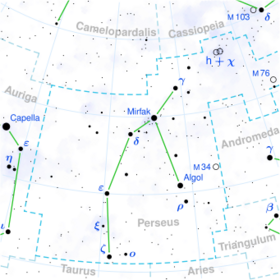Astronomy:54 Persei
| Observation data Equinox J2000.0]] (ICRS) | |
|---|---|
| Constellation | Perseus |
| Right ascension | 04h 20m 24.63885s[1] |
| Declination | 34° 34′ 00.2033″[1] |
| Apparent magnitude (V) | 4.93[2] |
| Characteristics | |
| Spectral type | G8+ IIIb[3] |
| U−B color index | +0.69[4] |
| B−V color index | +0.95[4] |
| Astrometry | |
| Radial velocity (Rv) | −26.82[5] km/s |
| Proper motion (μ) | RA: −25.046[1] mas/yr Dec.: −6.420[1] mas/yr |
| Parallax (π) | 14.8484 ± 0.1993[1] mas |
| Distance | 220 ± 3 ly (67.3 ± 0.9 pc) |
| Absolute magnitude (MV) | 0.80[6] |
| Details[7] | |
| Mass | 2.57±0.10 M☉ |
| Radius | 9.37±0.22 R☉ |
| Luminosity | 50.7±2.0 L☉ |
| Surface gravity (log g) | 2.93±0.03 cgs |
| Temperature | 5,036±32 K |
| Metallicity [Fe/H] | +0.11±0.10 dex |
| Rotational velocity (v sin i) | 1.8[8] km/s |
| Age | 580±90 Myr |
| Other designations | |
| Database references | |
| SIMBAD | data |
54 Persei is a single[10] star in the northern constellation of Perseus. It is visible to the naked eye as a faint, yellow-hued star with an apparent visual magnitude of 4.93.[2] The star is located approximately 220 light years away based on parallax, but is drifting closer with a radial velocity of −27 km/s.[5]
This is an aging giant star with a stellar classification of G8+ IIIb,[3] a star that has exhausted the supply of hydrogen at its core and expanded to more than nine times the girth of the Sun. It is around 580 million years old with 2.6 times the mass of the Sun. The star is radiating 51 times the luminosity of the Sun from its enlarged photosphere at an effective temperature of 5,036 K.[7] It has one distant visual companion, designated component B, at an angular separation of 93″ and magnitude 13.0.[11]
References
- ↑ 1.0 1.1 1.2 1.3 1.4 Brown, A. G. A. (August 2018). "Gaia Data Release 2: Summary of the contents and survey properties". Astronomy & Astrophysics 616: A1. doi:10.1051/0004-6361/201833051. Bibcode: 2018A&A...616A...1G. Gaia DR2 record for this source at VizieR.
- ↑ 2.0 2.1 Anderson, E.; Francis, Ch. (2012). "XHIP: An extended hipparcos compilation". Astronomy Letters 38 (5): 331. doi:10.1134/S1063773712050015. Bibcode: 2012AstL...38..331A. Vizier catalog entry
- ↑ 3.0 3.1 Keenan, Philip C.; McNeil, Raymond C. (1989). "The Perkins catalog of revised MK types for the cooler stars". Astrophysical Journal Supplement Series 71: 245. doi:10.1086/191373. Bibcode: 1989ApJS...71..245K.
- ↑ 4.0 4.1 Mermilliod, J. C. (2006). "Homogeneous Means in the UBV System (Mermilliod 1991)". VizieR On-line Data Catalog: II/168. Originally Published in: Institut d'Astronomie 2168. Bibcode: 2006yCat.2168....0M.Vizier catalog entry
- ↑ 5.0 5.1 Jofré, E. et al. (2015). "Stellar parameters and chemical abundances of 223 evolved stars with and without planets". Astronomy & Astrophysics 574: A50. doi:10.1051/0004-6361/201424474. Bibcode: 2015A&A...574A..50J. Vizier catalog entry
- ↑ Da Silva, Ronaldo et al. (2015). "Homogeneous abundance analysis of FGK dwarf, subgiant, and giant stars with and without giant planets". Astronomy & Astrophysics 580: A24. doi:10.1051/0004-6361/201525770. Bibcode: 2015A&A...580A..24D. Vizier catalog entry
- ↑ 7.0 7.1 Reffert, Sabine et al. (2015). "Precise radial velocities of giant stars". Astronomy & Astrophysics 574: A116. doi:10.1051/0004-6361/201322360. Bibcode: 2015A&A...574A.116R. Vizier catalog entry
- ↑ De Medeiros, J. R.; Mayor, M. (1999). "A catalog of rotational and radial velocities for evolved stars". Astronomy and Astrophysics Supplement Series 139 (3): 433. doi:10.1051/aas:1999401. Bibcode: 1999A&AS..139..433D. Vizier catalog entry
- ↑ "54 Per". SIMBAD. Centre de données astronomiques de Strasbourg. http://simbad.u-strasbg.fr/simbad/sim-basic?Ident=54+Per.
- ↑ Eggleton, P. P.; Tokovinin, A. A. (September 2008). "A catalogue of multiplicity among bright stellar systems". Monthly Notices of the Royal Astronomical Society 389 (2): 869–879. doi:10.1111/j.1365-2966.2008.13596.x. Bibcode: 2008MNRAS.389..869E.
- ↑ Mason, Brian D. et al. (2001). "The 2001 US Naval Observatory Double Star CD-ROM. I. The Washington Double Star Catalog". The Astronomical Journal 122 (6): 3466. doi:10.1086/323920. Bibcode: 2001AJ....122.3466M. Vizier catalog entry
 |


